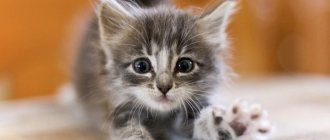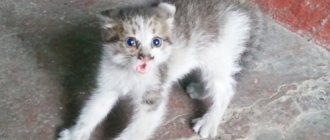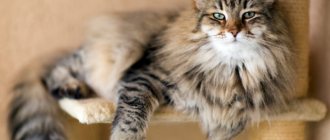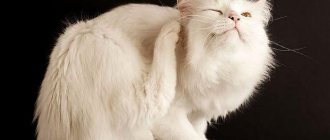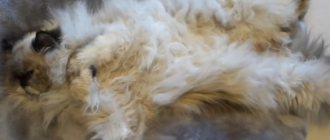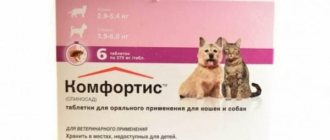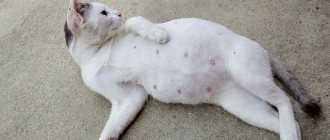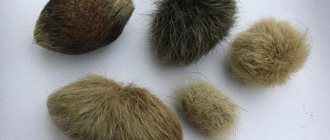When an owner takes a cat into a house or apartment, he is not even aware of the upcoming problems. Everyone thinks that cats are just animals, affectionate, beautiful and loving. But no one thinks that during the molting season, and even outside the season, the cat “sheds” its fur: on clothes, carpets, and pieces of furniture. And then cat owners grumble that the cat is so and so, leaving its lint everywhere. To get rid of cat hair from the carpet or on clothes, you need to follow basic hygiene rules (for your pet), follow useful tips for cleaning up hair, and feed your pet properly. So, how to remove cat hair from a carpet? How to deal with the hated “insulation” of cat origin? Let's get a look!
Why does a cat have a lot of hair?
Shedding in cats is a seasonal phenomenon. Both house and yard mooses shed their fur in spring and autumn, but the first moults also shed in winter - during the heating season. The undercoat of cats also falls out significantly after childbirth due to hormonal changes in the body. This is normal, you will just have to wait out this period.
However, if your cat's hair is growing so bad that bald spots appear on his thick hair, you should immediately consult a veterinarian. This may indicate a vitamin deficiency or a serious illness.
Rubber brush
A rubber brush does a great job of removing cat hair. It is enough to moisten a simple device and walk it over the dirty places. The brush collects the remaining hair. It is necessary to constantly wet it in warm water and use it several times until the coating becomes clean and smooth.
It is useful for cleaning the bathroom, toilet and kitchen. Many pet owners install cat litter in their bathroom or toilet. Cats are big fans of not only relieving themselves, but also of sitting on a drain barrel, a bathroom sink, or a bowl of laundry. Their fur floats in the air, on the tiles and floors of the room, which must be kept meticulously clean. A rubber brush does this job well. The tool cleans floors, tiles and other surfaces.
My cat has a lot of hair coming out, what should I do?
Owners often wonder: what to do to prevent a cat from shedding? To minimize the scale of the disaster, make it a habit to stroke the fur once a day with a special mitten. Brush long-haired cats with brushes. In the summer, the animal can be taken to a groomer, who will give it an interesting haircut, for example, a la lion.
Interesting.
Cats use their own method of getting rid of excess fur - licking. Veterinarians recommend giving your pet a special paste to remove hair from the stomach, or offering to chew green grass.
How to brush cats' fur? It all depends on the breed. There is a misconception that it is better to comb Persians with slicker brushes. In fact, this tool is not suitable, since it severely injures the soft, literally airy fur of the cat. Pay attention to combs or brushes made of quality materials. Short-haired cats can be combed with a rubber mitten, British and Scottish cats can be combed with a furminator, which does an excellent job in the undercoat. Comb the Maine Coon's luxurious coat with combs.
Take care of the proper nutrition of the animals - feed them exclusively high-quality dry or wet food, and best of all, holistic food. Consider switching to the BARF feeding system, which is based on feeding animals fresh meat, vegetables and fruits. This will maintain the balance of vitamins and minerals and keep your pet healthy.
Wall-mounted corner cat brushes are another way to reduce the amount of lint in your apartment. They are fixed on the protruding corners and treated with catnip. The cat will appreciate such a device and will be happy to rub its whole body against it. Murka - pleasure, less hassle for you!
Most cats do not like to bathe, but once every six months you can organize a bath day and wash the animal with shampoo. Choose a detergent based on your coat type and length. Complete the procedure with conditioner, which will help reduce static and smooth hairs.
Proper cat care
When dealing with such a phenomenon as animal molting, proper pet care, which includes several factors, will help.
Nutrition as a way to combat cat hair loss
To reduce the number of clumps of fur in the apartment, you need to pay attention to the correct nutritional process of the pet. Veterinarians recommend fairly simple rules to ensure adequate nutrition for your cat:
- Mixing natural and dry food is strictly prohibited.
- If the cat is fed natural food, then it is necessary to balance the pet’s diet. It should include: beef, vitamins, vegetables, mineral supplements.
- If a cat eats dry food, then it is strictly forbidden to use cheap options, because they harm the pet’s body.
- Veterinary pharmacies stock supplements that strengthen the animal's fur.
Combing wool
This method can only be used during the animal’s molting period. This will not only keep the apartment clean, but also keep the cat’s coat in great shape. Combing should be done daily, for this you can use:
- A special metal comb.
- With a slicker brush.
- With a brush or glove.
- A tangle cutter is used when a pet has tangles.
- Furminator. This is an excess hair destroyer that can replace all of the above tools.
- Some owners use such an extreme method as vacuuming the cat; for this purpose they use a silent vacuum cleaner with a special attachment.
It is better to comb the cat after washing. Washing itself as a way to combat shedding is not effective. After the cat has been washed with a special shampoo, while the fur is wet, you can begin combing. This way the cleansing will be more effective.
Humidity control can also be used as a method to control unwanted cat hair in your home. Dry and hot air leads to more active molting.
Of course, with the appearance of a cat in the house, not only comfort appears, but also some problems. If desired, you can avoid special problems during the molting period of the animal in quite accessible ways.
How to deal with cat hair in an apartment
What to do if a cat sheds and how to remove hair from the floor, furniture and clothes? We will share with you universal methods of dealing with fluff in the house.
How to remove wool from the floor
The main assistant of any cat owner is a vacuum cleaner. Ideally, of course, a robot vacuum cleaner that will do all the work on its own while you enjoy a cup of aromatic tea. A regular vacuum cleaner does just as well, but requires your participation.
Wet cleaning should ideally be done daily, but rubbing with a cloth or waving a mop is very labor-intensive, and a home cleaner equipped with a surface-washing function will help you with this. However, a wet cloth perfectly collects hairs that a vacuum cleaner couldn’t handle. There are also special mops on sale with a rubber coating in the form of a roller that attracts hairs.
How to get rid of wool on a carpet
A turbo brush is the best way to remove wool from carpets. It wraps hairs and makes cleaning much easier. You can also use a stiff brush, but few people like crawling on the carpet on all fours.
How to clean furniture
Use a vacuum cleaner to clean furniture. Brush from top to bottom, first vacuum the shelves, then the fronts of the cabinets, then work on the window sills and only then move on to the beds and sofas.
There is an old but proven method for removing cat hair from upholstery: wet a sheet, cover the chair or sofa and tap it firmly with a beater.
How to remove cat hair from clothes and textiles
How to get rid of wool on clothes? It sticks to all fabrics and glitters treacherously on the street, revealing you as the owner of the cat. Hairs are especially noticeable on dark things.
The easiest way to remove hairs is with a wet palm. Run your hand over the clothing from top to bottom, rolling the wool into balls.
Use sticky rollers to clean things, choose reusable solid gel rollers to save your family budget. They can be washed with water.
To reduce static, wash clothes with conditioner or treat them with an antistatic agent. Keep closets closed and clothes hidden in covers.
Useful tips
- It is advisable that the purr does not sleep in bed with the owner. In this case, you will not have to change your bed linen every day. If the owner still allows his pet to sleep in the bed, then he will have to change the bed linen at least once a week and wash it as usual with an additional rinse.
- To prevent hair from collecting on clothes, furniture and other fabric surfaces, it is necessary to use an antistatic agent. Using this product, you can make it easier to remove animal hair from the carpet, since the antistatic agent prevents the hairs from getting tangled.
- To get rid of cat hair on clothes, you need to put an antistatic cloth in the drum before washing. It will prevent lint from being attracted to clothing items.
- To effectively deal with cat “hair”, you can make a sticky roller yourself. To do this, you need a rolling pin and wide tape (sticky tape). Next, you should align the end of the adhesive tape with the end of the rolling pin and wrap the object in a spiral with the sticky side facing you and the smooth side facing the rolling pin. When the spiral ends, the tape needs to be cut. The prepared rolling pin should be passed along the fabric surfaces from top to bottom.
- To remove cat hair, especially if it is a long-haired cat, you can use a regular dish sponge. You need to wet and squeeze the sponge well to remove excess moisture, and then walk along the surfaces from top to bottom with the rough side. It is recommended to capture small areas.
- You can also remove wool in an apartment or house this way: take nylon or nylon tights, stick your hand into the sock and run it over the fabric. The lint will stick to the nylon.
If you don’t know how to get rid of long or short cat hair in a house or apartment, you can follow the suggested tips. The main thing is to be patient, love your pet, pamper it, keep it in decent conditions, and your pet will respond with love and affection.
How to use cat hair
Does cat fur have any uses? Of course, you don’t have to throw it away, but put it to use. The hair has a gorgeous shine and a silky structure. From wool you can make a blanket, mattress cover, blanket, sciatica belt, and use fluff for wet and dry felting.
The dry felting method is used to create three-dimensional products. The fibers are tightly connected and form felt. Wet felting is ideal for creating small toys or decorations.
In Switzerland, cat hair has long been used to treat osteochondrosis. Their fluff is used to make belts and socks to increase blood circulation and relieve joint pain.
Some craftsmen make expensive jewelry and designer bags from wool.
Soft sponges
Use soft, moistened sponges to remove pet hair. They are usually used when washing dishes. They are sold in every hardware department and are very cheap. The sponge easily picks up shaggy residues that settle on furniture and floors. Before cleaning, you need to moisten it in warm water and rub it over the contaminated surface.
Rubber gloves, which housewives often use in everyday life, are an excellent option for cleaning cat hair. Wet gloves are enough to walk over the contaminated area. The lint sticks to the rubber base of the gloves, which helps them get rid of them quickly.
Tips and tricks for pet owners
We have collected tips for caring for cats that will make your life easier:
- Provide your pet with a place to sleep, eat, and go to the toilet. Buy bowls for water and food, as well as a mat for them, as some cats eat sloppily, spilling water and scattering food on the floor. Place the house and scratching post in the corner of the room.
- Bathe your cat once every 3-6 months if she does not go outside for walks. If your pet is free-range, you will have to bathe it more often, because dust, dirt, and dry grass stick to its coat. The optimal water temperature is 38-38.5°C. Long-haired cats can be blow-dried on low setting.
- Brush short-haired cats once a week, or several times during the shedding period. Brush long-haired cats daily and trim mats if necessary. Remember, the softer the fur, the softer the brush, and vice versa.
- Trim the nails once every 2 weeks with a nail clipper, being careful not to catch a blood vessel.
- Clean your eyes and nose daily with a damp cloth or swab. If purulent discharge appears, contact your veterinarian.
- Clean your ears with a special lotion once a week. Earwax should be light in color and without an unpleasant odor; if it is darkened and smells bad, take your pet to the veterinary clinic.
- If there is no solid food in the diet, the cat needs to brush its teeth from plaque and tartar once a week with toothpaste for cats.
- Once every three months, it is necessary to show the animal to a veterinarian and promptly vaccinate. A specialist will examine your pet and be able to identify serious diseases in time. 10 days before vaccination, treat for worms.
Animal cleaning glove
Cat lint sticks to the floor and is sometimes difficult to get rid of. You can clean the surface from shedding cat hair using a combing glove. It is enough to run a glove over your pet's fur once a day. This will make your hair healthy, shiny and help remove excess hair particles. Thus, excess hair disappears from cats in one fell swoop, and protects the environment from unpleasant sticky fluff. A simple daily procedure will not leave cats indifferent, causing them to purr contentedly and have a well-groomed, pleasant appearance.
Shedding and ways to deal with it
Cause and investigation
There are cat breeds that shed all year round. These include popular Britons. Such pets need to be combed daily with a special furminator.
What can happen to a pet in case of active molting? Most often, the reason for this is a banal lack of vitamins, skin or intestinal infections, and exhaustion.
If you consult a specialist in time and carry out a course of treatment, the animal’s health will be restored and problems with excessive hair loss will go away on their own.
Silicone roller
The silicone roller is quite practical because it is reusable, you just need to wet it, it will become viscous and pick up all the hair and dirt from any area. There are many sizes and prices, with a long detachable handle, up to the size of a foldable bag, so you can always carry it with you. You can buy them in cleaning stores, supermarkets... the price depends on the quality, the cheaper it is, the faster the silicone wears out and the less it will last. This is definitely a good cleaning method and is more environmentally friendly than rollers or tape.
Features of shedding of some breeds
How a cat sheds is largely determined by its breed. The amount of hair left behind by a shedding cat is affected not only by the length of its coat (guard hair), but also by the density and length of the undercoat.
If we consider cat breeds according to the intensity of shedding, they can be divided into:
- highly shedding cats with a lot of undercoat: Persian and Himalayan cats;
- Maine Coon;
- British cat;
- Angora cat;
- Siamese cat;
- sphinxes - depending on the variety, hair may be completely absent or its length may be no more than 2 mm;
Shedding in sphinxes is minimal due to the almost complete absence of hair.
Preventive measures to help reduce shedding
There are several measures that can reduce hair loss. Remember that every hair you remove from your pet is less hair that needs to be removed.
One simple way to reduce shedding is to brush your dog every day. The procedure should not be very long. A few minutes of brushing will help get rid of a lot of loose fur.
Regular washing also helps reduce shedding. There is no magic shampoo that works better than others. Just the physical action of water removes a lot of hair. Feeding high quality food reduces excessive loss. And of course, remember about parasites in animals that can cause hair loss. Give your pet health and safe removal of worms with the help of a natural complex.
Masking tape
We all know adhesive tape for packing boxes, they are cheap and the glue inside them perfectly collects all the hairs from any surface. The only downside is that you have to cut and glue the strips, which is a slower and more cumbersome process. A trick to make this a little faster would be to wrap the non-stick part in two or three layers in your hand so that the glue is on the outside and thus can be used as if it were a brush on the surfaces.
© shutterstock
How a cat sheds
Before you take measures to get rid of cat hair, you need to know exactly what type of shedding your pet undergoes. It could be:
- Seasonal molt . It usually occurs in autumn and spring and is characterized by increased intensity. This is a completely normal period in a cat's life. This is how nature renews her hair.
- Constant loss of hairs . Just as a person loses a certain amount of hair every day, a cat sheds its fur.
- Unexpected loss . If a cat suddenly begins to lose hair in “pieces”, this is always a dangerous symptom associated with some kind of disease. The pet needs to be taken to the vet immediately.
Devices for removing hair loss
There are high-quality suction devices that successfully remove wool residues on furniture and carpet. They can be purchased at specialty pet care stores.
Machine for combing wool.
This tool will please not only the owner, but also the animal. The mechanical device glides smoothly over the animal’s skin, cleaning the fur from excess hairs. The movement of the machine imitates soft stroking, so cats calmly allow the technical device to be used on themselves. Like a small vacuum cleaner, it gently sucks up excess hair, cleansing the animal's coat. At the same time, cats are happy about this procedure, responding to the caring owner with a satisfied purr.
Does the intensity of shedding depend on diet?
As cat owners already know, a pet that does not receive proper care and nutrition loses many times more fur - and without seasonal shedding. Now imagine how intensively the changing fur of a cat with a weak immune system will fall out. The most important thing here is proper nutrition. And only the owner can take care of this.
- You should never mix industrial and natural food in one “dish”. Experts recommend alternating days (or weeks) of feeding these two types of food.
- If a cat is fed natural food, the owner must monitor the pet’s receipt of all nutrients (meat, vegetables, vitamin and mineral supplements). It is best to discuss your mustache's diet with your veterinarian.
- Industrial feed should only be of premium and super premium classes. Cheap store-bought food options do no good at all; they only fill the cat’s stomach with harmful waste.
- On sale you can always find products and supplements to strengthen the hair of animals.
When is a cat's shedding a sign of a health problem?
Shedding as such is normal and is not a cause for concern. But there are circumstances when hair loss is a signal that you should consult a veterinarian.
An unhealthy symptom is considered if during molting:
- the cat is losing weight;
- hair loss is much more intense than usual;
- bald spots begin to appear;
- the general condition of the coat deteriorates significantly;
- Shedding occurs unevenly, affecting only a certain part of the body.
In such cases, the reasons for sudden intense baldness may be different, but consultation with a specialist is always required. The causes of the problem may be parasites, allergies, stress, hormonal imbalances, as well as other, more serious diseases.
Living with a cat means you have to accept more or less occasional shedding. It's worth remembering that every cat sheds a different amount of hair, and every person experiences it differently. What for one person means constant cleaning and fighting for a fur-free home is not a problem for another. If you do not want to periodically struggle with hair loss, you should think about choosing a breed of hairless cat, for example, a Sphynx or a Peterbald.

